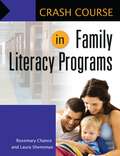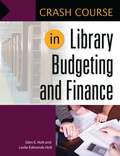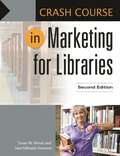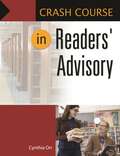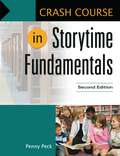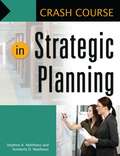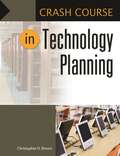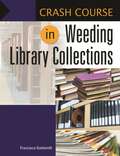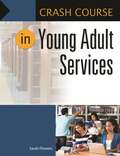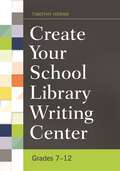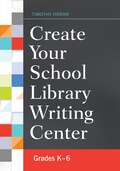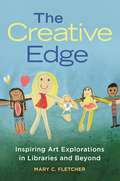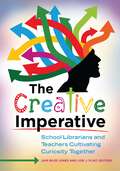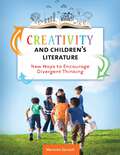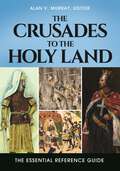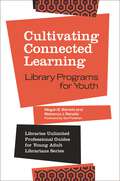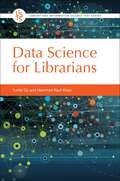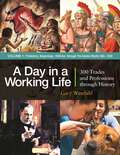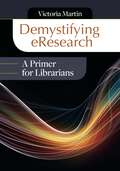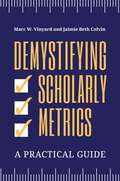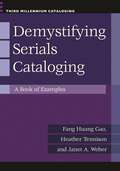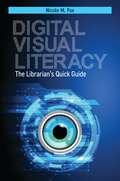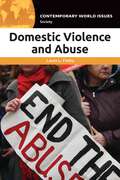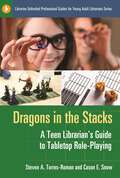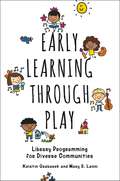- Table View
- List View
Crash Course in Family Literacy Programs (Crash Course)
by Rosemary Chance Laura ShenemanThis book collects the research on literacy, information regarding the importance of reading to children, sources of funding, and places to find information about literacy programs in the 50 states—all in a single volume.Family literacy programs can be remarkably effective in helping families who struggle in various areas of literacy or supporting their children's academic needs.Crash Course in Family Literacy Programs provides an introduction and an overview of this critical subject, defining what literacy, family literacy, and family literacy events are, and covering critical topics such as sources of funding, conclusions of recent research, and bilingual family literacy. The first half of the book is focused on laying out background information about family literacy, while the remainder provides practical how-to information for public and school libraries to develop their own family literacy programming. The book shows perspectives of public librarians, school principals, children's book store owners, and school personnel who have successfully implemented a family literacy program. Planning sheets and lesson templates are included, making it easy to develop a family literacy program.
Crash Course in Library Budgeting and Finance (Crash Course)
by Leslie Edmonds HoltConcise, informative, and well-indexed, this book helps readers get the "big picture" as well as the considerable number of details involved in managing the finances for a library.For all libraries, money is critical to decision-making about technology, staffing, and collections. As a result, informed budgeting is critically important for any library to succeed. This book explains library finance in a practical, engaging way, using examples of real situations in different types of libraries to teach key points. Written by authors with years of experience in budgeting and financial planning within a variety of library settings and in teaching library management or fundraising at the university level, Crash Course in Library Budgeting and Finance makes it painless to learn how to properly manage money in any library environment.The book addresses the entire process of financial planning, from a general, conceptual overview of library budgeting to the details of generating and spending income, and describes best practices for implementing financial controls. Subjects covered include building construction and capital projects, fund raising, capital campaigns, moving to fee-based services, extending and developing earned income, financial best practices, and assessment and evaluation. The authors also make recommendations regarding when and how to share relevant financial information throughout the organization and with constituents throughout the book.
Crash Course in Marketing for Libraries (Crash Course)
by Susan W. Alman Sara Gillespie SwansonExplains effective marketing strategies and identifies the tools needed to boost the visibility and increase the use of your library in the community.Marketing a library's programs or services takes more than sending out a flyer or posting an announcement on the website. Effective marketing is important for every library, as it can lead to a significant increase in library use—which is a major factor in budget justification. Crash Course in Marketing for Libraries: Second Edition will help you develop a strategic direction for your organization and identify methods for employing your best marketing and public relations strategies.Each chapter of this second edition has been updated and expanded, comprehensively addressing the planning, implementation, and evaluation stages of the marketing and public relations process in libraries. The rise of social media as a powerful marketing tool is discussed in particular detail. The authors cover topics such as planning, promoting through the use of the existing media or advertising, and assessing the project. The book's appendixes provide examples of marketing plans and projects as well as other helpful marketing resources.
Crash Course in Readers' Advisory (Crash Course)
by Cynthia OrrOne of the key services librarians provide is helping readers find books they'll enjoy. This "crash course" will furnish you with the basic, practical information you need to excel at readers' advisory (RA) for adults and teens.The question "can you recommend a good book?" can be one of the most daunting you face, notwithstanding the fact that recommender tools are ubiquitous. Often, uncertainty arises because, although librarians are called on to perform such services daily, readers' advisory is a skill set in which most have no formal training. This guide will remedy that. It is built around understanding books, reading, and readers and will quickly show you how to identify reading preferences and advise patrons effectively. You'll learn about multiple RA approaches, such as genre, appeal features, and reading interests and about essential tools that can help with RA. Plus, you'll discover tips to help you keep up with this ever-changing field.There is no other professional book that covers the full spectrum of skills needed to perform the RA service that is in such great demand in libraries of all kinds. Helping readers find what they want is a sure way to serve patrons and build your library's brand. You will come away from this easy-to-understand crash course with the solid background you need to do both.
Crash Course in Storytime Fundamentals (Crash Course)
by Penny PeckThis manual is a "one-stop shop" on how to present storytimes to suit different audiences including bilingual learners, special needs children, and those in a variety of settings such as Head Start, preschools, and day care situations.This beginner's guide to storytelling traces the developmental stages of very young children, illustrating how to present storytime for babies, toddlers, and preschoolers as well as in family settings to be most effective. Author Penny Peck will teach you the fundamentals of reading with the intent of capturing children's imaginations, showing you how to incorporate music, play, and hands-on activities into your routine. She offers expert advice on how to choose the best picture books and provides lists of books for addressing particular literacy needs.A perfect primer for those new to the task, this guide illustrates how to make this activity a favorite of children and provides tips for progressing in the role of storyteller, with ideas for engaging your audience and enhancing enjoyment. Beginning with the basics of performing a library storytime, each subsequent chapter builds on that knowledge, offering ways to infuse technology, special needs adaptations, and music into the story. The revised edition addresses such current topics as iPads, apps usage, online options, and dance programs.
Crash Course in Strategic Planning (Crash Course)
by Stephen A. Matthews Kimberly D. MatthewsFor practitioners, this text provides an easy-to-understand approach to strategic planning and execution.The general recipe for achieving an intended outcome is equal parts of the following: clear vision and mission, a practical strategic plan, daily activities linked to the mission, and unified commitment to the plan. However, orchestrating the details of these necessary components is somewhat more complicated.Crash Course in Strategic Planning uses a process approach to the creation of a strategic plan, providing practitioners with no-nonsense instruction on planning. The volume is arranged to lead the reader through the stages of planning, from the beginning development stages through the execution of the plan to completing the plan and attaining the objective. A variety of recommended planning techniques are supplied for groups to use to accomplish their planning goals, and the final chapter emphasizes the importance of overall organizational commitment to execution of the plan.
Crash Course in Technology Planning (Crash Course)
by Christopher D. BrownThis easy-to-use primer will empower anyone—even those with no IT background—to face the challenge of adding one or more technologies to library services or maintaining existing technologies.Most of the public libraries in the United States are operating on tight budgets without allocation for IT personnel; in school libraries, the librarian often takes on the lion's share of IT responsibility. This book is an invaluable guide for library staff members who are put in the position of maintaining their own networks and computers with very little training or support. Authored by an assistant library director with years of firsthand experience working as a solo IT manager within public libraries, this guide provides practical information about overcoming the unique challenges of managing IT in a smaller organization, juggling multiple job roles, being limited by a restrictive budget, and working directly with the public.Crash Course in Technology Planning addresses a wide variety of IT topics in the library sphere, providing information in a logical manner and order. It begins with an explanation of triaging existing IT issues, then moves into diagnosing and repairing both individual PCs as well as the library Local Area Network (LAN). The following chapters cover other important topics, such as the best way to inventory computers and equipment, how to budget for and procure new equipment, and recommended ways for an IT layperson to set and achieve goals.
Crash Course in Weeding Library Collections (Crash Course)
by Francisca GoldsmithWeeding is a perennial challenge for librarians. This book will help you rise to the task by offering you basic instructions, including information on new formats and digital collections.Weeding is often difficult—who can easily decide to discard books and other materials that someone may someday want to borrow? But weeding is essential to keeping your collection healthy and relevant. Perfect for all types of libraries and for both paraprofessionals and librarians unfamiliar with modern weeding methods, this practical guide offers clear guidance that can help you cope with the sometimes-paralytic fear and distaste that can accompany a must-do task. Each of the book's chapters treats a specific concern—for example, weeding electronic collections. Practical matters related to collection maintenance through material and online resource weeding are addressed, as are policy and procedure documentation and communication planning and best practices. You'll read about weeding ethics, using vendor-provided weeding tools, and floating collections. The book also shares advice on training volunteers as weeding assistants and on communicating with library stakeholders about collection maintenance. By showing you how to make weeding a normal part of your library's routine, this book will help you provide your community with a healthier, better circulating, and more valuable collection.
Crash Course in Young Adult Services (Crash Course)
by Sarah FlowersLearn how to improve teen services in public libraries by better understanding teen development and having positive interactions with teens to provide appropriate and interesting collections and services.A library can be a tremendous resource for teens—one that helps them to learn about themselves and the world they live in. But teenagers are intrinsically different from children and from adults, and these critical developmental differences affect the ways they interact with others, both in the world at large and in the library. Serving teens effectively in the library requires a basic understanding of who teens are and the developmental tasks they face—factors that affect all aspects of library service, from the specific programs and services we offer to the ways that staff provide assistance to the teen who is seeking help at a library service desk.This book enables library workers to better understand adolescent development, which allows them to provide a positive library experience for teens. Readers will learn how to supply excellent library services with and for teens, including in the areas of collection development, readers' advisory, reference and homework help, programming, and advocacy. The book identifies the best ways to have positive interactions with teens in the library based on their mental development and details best practices for teen services. The concluding section discusses advocating for teens, with emphasis on their right to privacy and equal access to materials and services.
Create Your School Library Writing Center: Grades 7–12
by Timothy HoranColleges typically have writing centers to which students can bring their writing assignments to a peer tutor for assistance, but most high schools and middle schools do not. This book advocates for the creation of writing centers in 7–12 schools and explains why the school library is the best place for the writing center.There is a glaring absence of writing centers in today's K–12 schools. More and more students are being asked in college entrance testing to submit samples of their writing, and employers are expecting their workers to write correctly and clearly. This book addresses the critical lack of writing centers below the undergraduate level. It demonstrates how middle school and high school librarians can create writing centers in their school libraries, explains how to assist students through a one-on-one writing tutorial method, and gives students and teachers the tools for learning and understanding the complex art of writing.Author Timothy Horan—inventor of the School Library Writing Center—establishes why school libraries represent the best—and most logical—places to create writing centers, and why school librarians are the natural choice to direct writing center operations. He then takes readers through the process of creating a writing center from original conception up through opening day. Additional topics covered include how to publicize and "grow" your School Library Writing Center; maintaining your writing center for efficient operation on a daily basis as well as for years to come; how to become an effective writing center director and writing tutor; the most current technology that can be used to assist in the writing, composition, and research process; and working with English language learner (ELL) students within your writing center.
Create Your School Library Writing Center: Grades K–6
by Timothy HoranThe inventor of the School Library Writing Center makes it easy for librarians and teachers of kindergarten through sixth grade learners to provide highly effective writing instruction.Students in the early years of their development have a tremendous capacity for learning. By focusing on providing authentic writing experiences for kindergarten through sixth grade students, librarians and teachers can help transform students into competent writers well before they reach middle school. Written by the inventor of the School Library Writing Center, this book is the only one of its kind. It gives you clear and easy-to-read instructions on how to create and structure engaging and productive lessons in writing as well as reproducible worksheets that are ready to implement in your library or classroom. Each worksheet relates directly to writing lessons discussed in the book and serves to guide students (and their teachers) as they explore the exciting world of writing.Readers will learn why and how they can create and maintain a School Library Writing Center. The book moves sequentially through the grade levels, starting with kindergarten and concluding at grade six, with each chapter focusing on a specific grade level. The author explains best practices with regards to tutoring writing in each grade; discusses the developmental levels and skills expected in a particular grade with regards to writing and reading; addresses grade-specific Common Core learning standards; discusses grade-appropriate online resources and technology-enabled activities that will help students become better writers; and identifies practical tutoring methods that will help students develop as writers.
The Creative Edge: Inspiring Art Explorations in Libraries and Beyond
by Mary C. FletcherLibrary facilitators of art-based creativity sessions will learn how to choose materials and art experiences appropriate for young people from toddlers to teens and for intergenerational groups.In the modern world, innovative and creative individuals have a distinct advantage: the creative edge. The Creative Edge explains how you can design and conduct art-based creativity programming in your library. Written by a library creativity specialist, this book is the result of the author's many years of experience facilitating art groups for all ages. Her programs have achieved national recognition and will serve as a guide for others to establish art-based creativity sessions. In this book, she incorporates research that documents the importance of creativity as an essential component of childhood development and connects it to library learning goals, including literacy.Creativity research can be applied in libraries and at other public institutions to develop programs that will meet the needs of the next generation. The book includes many practical elements, such as lists for recommended art materials, step-by-step instructions on setup and procedures, and ideas inspired by picture book illustrations that connect to story time themes. The Creative Edge teaches readers how to provide programs that promote child-led exploration, experiential learning, innovative thought, and creative confidence.
The Creative Imperative: School Librarians and Teachers Cultivating Curiosity Together
by Jami Biles Jones and Lori J. FlintProvides a solid, foundational understanding of creativity that enables readers to elicit creative performance from their students.The first book of its kind in the school library field, The Creative Imperative: School Librarians and Teachers Cultivating Curiosity Together assists educators, school librarians, school counselors, and parents in learning about creativity and inquiry as well as how to foster these desired processes in school settings and beyond. The work begins by addressing the foundational aspects of creativity, and then discusses creativity within the educational setting, exploring how educators can be more creative themselves and coax creative performance from their students. The final part of the text focuses specifically on school libraries and the role of librarians in developing environments and opportunities for inquiry that nurture creativity.
Creativity and Children's Literature: New Ways to Encourage Divergent Thinking
by Marianne SaccardiToday's students need to be able to do more than score well on tests—they must be creative thinkers and problem solvers. The tools in this book will help teachers and parents start students on the path to becoming innovative, successful individuals in the 21st century workforce.The children in classrooms today will soon become adult members of society: they will need to apply divergent thinking skills to be effective in all aspects of their lives, regardless of their specific occupation. How well your students meet complicated challenges and take advantage of the opportunities before them decades down the road will depend largely upon the kind of thinking they are trained and encouraged to do today. This book provides a game plan for busy librarians and teachers to develop their students' abilities to arrive at new ideas by utilizing children's books at hand.Following an introduction in which the author defines divergent thinking, discusses its characteristics, and establishes its vital importance, chapters dedicated to types of literature for children such as fantasy, poetry, and non-fiction present specific titles and relevant activities geared to fostering divergent thinking in young minds. Parents will find the recommendations of the kinds of books to read with their children and explanations of how to engage their children in conversations that will help their creative thinking skills extremely beneficial. The book also includes a case study of a fourth-grade class that applied the principles of divergent thinking to imagine innovative designs and come up with new ideas while studying a social studies/science unit on ecology.
The Crusades to the Holy Land: The Essential Reference Guide
by Alan V. Murray, EditorBased on the latest scholarship by experts in the field, this work provides an accessible guide to the Crusades fought for the liberation and defense of the Holy Land—one of the most enduring and consequential conflicts of the medieval world.The Crusades to the Holy Land were one of the most important religious and social movements to emerge over the course of the Middle Ages. The warfare of the Crusades affected nearly all of Western Europe and involved members of social groups from kings and knights down to serfs and paupers. The memory of this epic long-ago conflict affects relations between the Western and Islamic worlds in the present day. The Crusades to the Holy Land: The Essential Reference Guide provides almost 90 A–Z entries that detail the history of the Crusades launched from Western Europe for the liberation or defense of the Holy Land, covering the inception of the movement by Pope Urban II in 1095 up to the early 14th century. This concise single-volume work provides accessible articles and perspective essays on the main Crusade expeditions as well as the important crusaders, countries, places, and institutions involved. Each entry is accompanied by references for further reading. Readers will follow the career of Saladin from humble beginnings to becoming ruler of Syria and Egypt and reconquering almost all of the Holy Land from its Christian rulers; learn about the main sites and characteristics of the castles that were crucial to the Christian domination of the Holy Land; and understand the key aspects of crusading, from motivation and recruitment to practicalities of finance and transport. The reference guide also includes survey articles that provide readers with an overview of the original source materials written in Latin, Arabic, Greek, Hebrew, Armenian, and Syriac.
Cultivating Connected Learning: Library Programs for Youth (Libraries Unlimited Professional Guides for Young Adult Librarians Series)
by Megan E. Barrett Rebecca J. RanalloIf you want to boost your library's relevancy and support youth learning, consider incorporating connected learning at your library. This book helps you to realize the potential of this exciting and dynamic trend.Learning doesn't just happen in the classroom: it happens everywhere. The connected learning model supports this principle, asserting that young people learn best when their experiences are interest-driven, peer-supported, and rooted in solid academics. Libraries are the perfect environment for this type of learning, providing a place where teens can connect with each other and with adult mentors to engage with learning material and thrive. This book shows you how to cultivate connected learning in your library. You'll discover what the approach involves, its benefits, and what it can look like in various library settings. You'll also learn how to generate support for connecting learning within your library; reimagine your spaces and programs to better support connected learning; integrate technology into programs and services to make it accessible to youth; build partnerships with other libraries as well as other organizations; recruit volunteers; and raise community awareness to increase involvement.
Data Science for Librarians (Library and Information Science Text Series)
by Yunfei Du Hammad Rauf KhanThis unique textbook intersects traditional library science with data science principles that readers will find useful in implementing or improving data services within their libraries.Data Science for Librarians introduces data science to students and practitioners in library services. Writing for academic, public, and school library managers; library science students; and library and information science educators, authors Yunfei Du and Hammad Rauf Khan provide a thorough overview of conceptual and practical tools for data librarian practice. Partially due to how quickly data science evolves, libraries have yet to recognize core competencies and skills required to perform the job duties of a data librarian. As society transitions from the information age into the era of big data, librarians and information professionals require new knowledge and skills to stay current and take on new job roles, such as data librarianship. Such skills as data curation, research data management, statistical analysis, business analytics, visualization, smart city data, and learning analytics are relevant in library services today and will become increasingly so in the near future. This text serves as a tool for library and information science students and educators working on data science curriculum design.
A Day in a Working Life [3 volumes]: 300 Trades and Professions through History [3 volumes]
by Gary WestfahlIdeal for high school and college students studying history through the everyday lives of men and women, this book offers intriguing information about the jobs that people have held, from ancient times to the 21st century.This unique book provides detailed studies of more than 300 occupations as they were practiced in 21 historical time periods, ranging from prehistory to the present day. Each profession is examined in a compelling essay that is specifically written to inform readers about career choices in different times and cultures, and is accompanied by a bibliography of additional sources of information, sidebars that relate historical issues to present-day concerns, as well as related historical documents.Readers of this work will learn what each profession entailed or entails on a daily basis, how one gained entry to the vocation, training methods, and typical compensation levels for the job. The book provides sufficient specific detail to convey a comprehensive understanding of the experiences, benefits, and downsides of a given profession. Selected accompanying documents further bring history to life by offering honest testimonies from people who actually worked in these occupations or interacted with those in that field.
Demystifying eResearch: A Primer for Librarians
by Victoria MartineResearch presents new challenges in managing data. This book explains to librarians and other information specialists what eResearch is, how it impacts library services and collections, and how to contribute to eResearch activities at their parent institutions.Today's librarians need to be technology-savvy information experts who understand how to manage datasets. Demystifying eResearch: A Primer for Librarians prepares librarians for careers that involve eResearch, clearly defining what it is and how it impacts library services and collections, explaining key terms and concepts, and explaining the importance of the field. You will come to understand exactly how the use of networked computing technologies enhances and supports collaboration and innovative methods particularly in scientific research, learn about eResearch library initiatives and best practices, and recognize the professional development opportunities that eResearch offers.This book takes the broad approach to the complex topic of eResearch and how it pertains to the library community, providing an introduction that will be accessible to readers without a background in electronic research. The author presents a conceptual overview of eResearch with real-world examples of electronic research activities to quickly increase your familiarity with eResearch and awareness of the current state of eResearch librarianship.
Demystifying Scholarly Metrics: A Practical Guide
by Marc W. Vinyard Jaimie Beth ColvinDemystifying Scholarly Metrics gives librarians and faculty the confidence to navigate the maze of scholarly metrics, identify quality journals in which to publish, and measure the impact of scholarly works.Both librarians and professors can be overwhelmed by the bewildering number of scholarly metrics. This user-friendly book demystifies them, helping librarians become familiar with scholarly metrics and giving them the confidence to assist faculty at their institutions. It also equips faculty authors with the knowledge to evaluate journals and use metrics to track their scholarly impact.Several controversies exist in the scholarly metrics landscape, including a disagreement between the proponents of altmetrics and traditional bibliometrics. Even more contentious debates are breaking out over predatory journals and open access publishing. Authors Mark Vinyard and Jaimie Beth Colvin, who successfully launched a faculty publishing initiative, explain which aspects of metrics are truly essential to grasp, and they place these numbers in context. They help readers identify the metrics that are the best fit for their scholarship and give librarians and professors the tools to make smart decisions in this changing scholarly metrics landscape.
Demystifying Serials Cataloging: A Book of Examples (Third Millennium Cataloging)
by Fang Huang Gao Heather Tennison Janet A. WeberThis essential reference teaches library staff how to handle the most common and confusing problems in serials cataloging by providing clear examples, practice exercises, and helpful advice based on experience.Serials cataloging can be an overwhelming task that frustrates even the most seasoned professional. This book provides simple guidance and real-world examples to illustrate best practices in serials cataloging.Demystifying Serials Cataloging: A Book of Examples is a reliable reference for learning how to catalog serials or improve cataloging skills. The book covers important elements of descriptive cataloging of serial publications such as explanations, sample records, applicable cataloging rules, and images of the serials. Examples demonstrate best practices and guidelines from the industry's leading cataloging standards including Anglo-American Cataloguing Rules: Second Revised Edition; CONSER Cataloging Manual; Library of Congress Rule Interpretation; and OCLC Bibliographic Formats and Standards. Each chapter contains helpful practice exercises to ensure understanding and reinforce learning.
Digital Visual Literacy: The Librarian's Quick Guide
by Nicole M. FoxDesigned to introduce visual literacy to instructional librarians, this book shows librarians how to make visual literacy relevant and engaging by framing it as a digital skill.Millions of images are uploaded to social media every day, and students are increasingly being asked to participate in such image-rich research projects as websites and blogs. Image manipulation and photo editing are commonplace, but the visual literacy skills needed to detect that kind of misinformation aren't.Students need help learning how to find, evaluate, and use images in an ethical and effective manner. Digital Visual Literacy is designed to introduce visual literacy to instructional librarians. This concise introduction teaches visual literacy as a digital skill, complete with digital humanities-based workshops and assignments to make instruction informative and engaging. It covers all aspects of visual literacy, from copyright to image evaluation. Each chapter clearly explains visual literacy standards and proficiencies and offers practical instructional assignments, in-class demonstrations, and more through the use of digital humanities tools.
Domestic Violence and Abuse: A Reference Handbook (Contemporary World Issues)
by Laura L. FinleyA comprehensive and timely resource for students, activists, educators, and advocates, Domestic Violence and Abuse: A Reference Handbook provides a rich and scholarly assessment of this important social issue while also including stories and profiles for a more personal understanding.Domestic Violence and Abuse: A Reference Handbook provides a thorough review of the most recent research about intimate partner violence. Additionally, a historical review provides readers with a sense of how views on domestic violence have changed over time and how different policies and practices have and have not been successful. Appropriate for readers at the high school level and above, the volume focuses on the scope, extent, and characteristics of domestic violence and offers several unique elements, including profiles of significant individuals, personal stories from advocates, activists and survivors, and a review of controversial issues. The volume also includes a chronology of key events, relevant data and documents, primary source data, and recommended resources.
Dragons in the Stacks: A Teen Librarian's Guide to Tabletop Role-Playing (Libraries Unlimited Professional Guides for Young Adult Librarians Series)
by Steven A. Torres-Roman Cason E. SnowA one-stop, complete guide to tabletop role-playing games for novice librarians as well as seasoned players.Tabletop role-playing games (RPGs) are a perfect fit for library teen services. They not only hold great appeal for teen patrons, but also help build important skills ranging from math and literacy to leadership and dramatics. Role-playing games are cost-effective too. Dragons in the Stacks explains why RPGs are so effective at holding teenagers' attention, identifies their specific benefits, outlines how to select and maintain a RPG collection, and demonstrates how they can enhance teen services and be used in teen programs. Detailed reviews of role-playing games are included as well, with pointers on their strengths, weaknesses, and library applications. Coauthored by an experienced young adult librarian and an adult services librarian, this is the definitive guide to RPGs in the library, and the only one currently available.
Early Learning through Play: Library Programming for Diverse Communities
by Kristin Grabarek Mary R. LanniThis creative guidebook teaches librarians in diverse communities how to develop and implement early learning programming beyond traditional storytimes.While traditional library storytimes are excellent tools for families, equally important is play. Children learn through play in many ways; it stimulates exploration and curiosity and builds gross and fine motor skills that are critical to reading and writing success. Perhaps most importantly, play has the power to cross barriers of culture and language, allowing families from differing backgrounds to learn together.In this book, Kristin Grabarek and Mary R. Lanni—the pioneers of Little University, an early learning program that focuses on play-based learning—share their experiences and provide guidance for implementing similar programs at libraries of various sizes and budgets. They teach readers how to create programs for a diverse group of families, work with outside providers, choose supplies, estimate costs, market your programming, and overcome the challenges of both big and small budgets and many or few patrons. These practical plans will enhance storytimes and even help build a brand-new early learning program.
